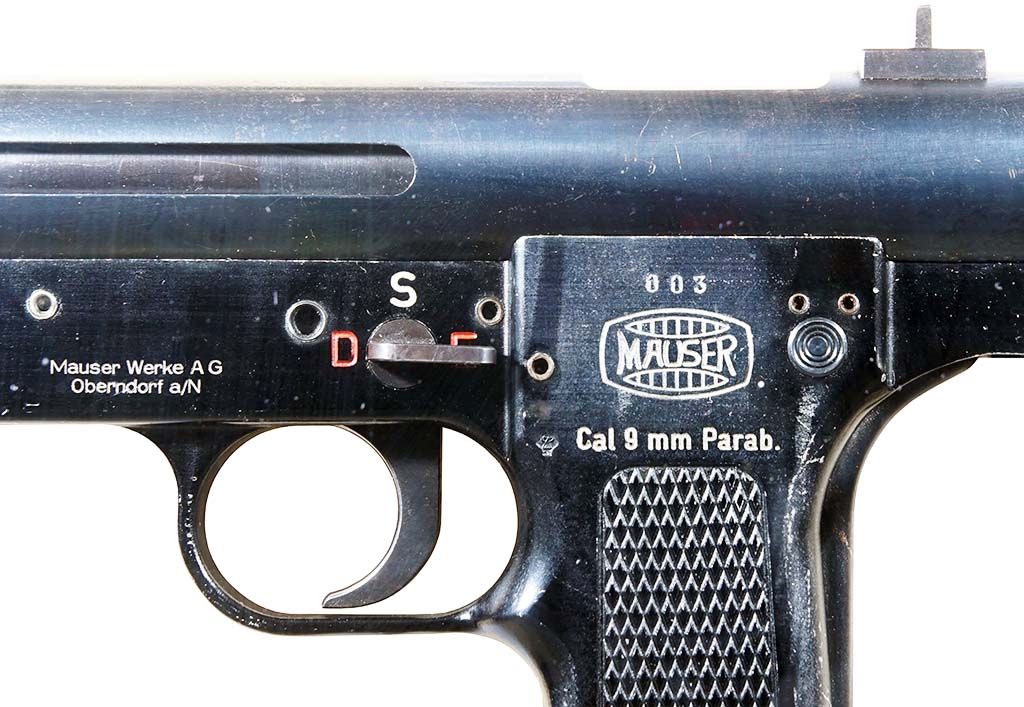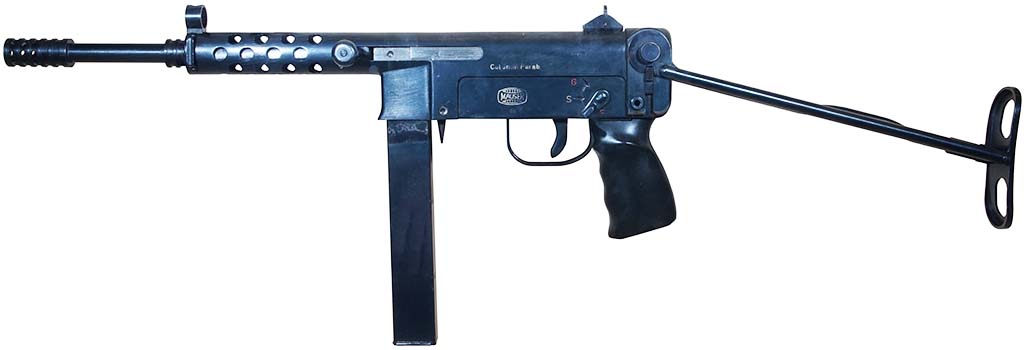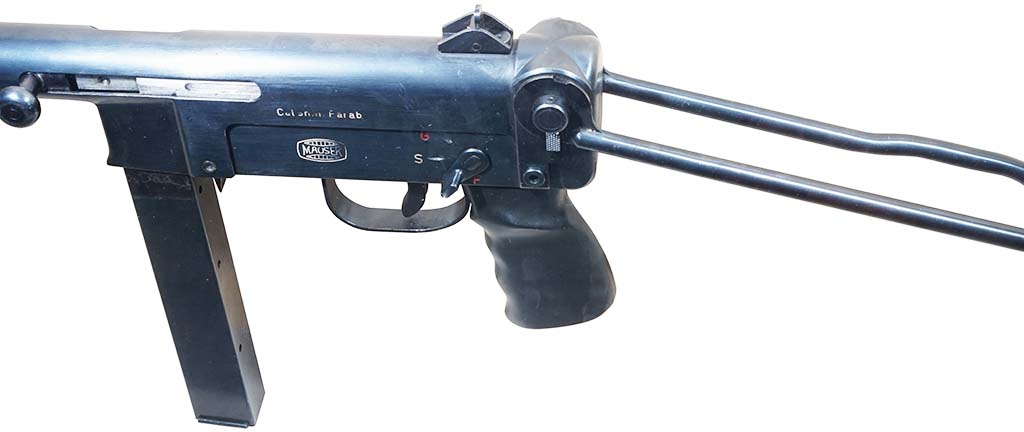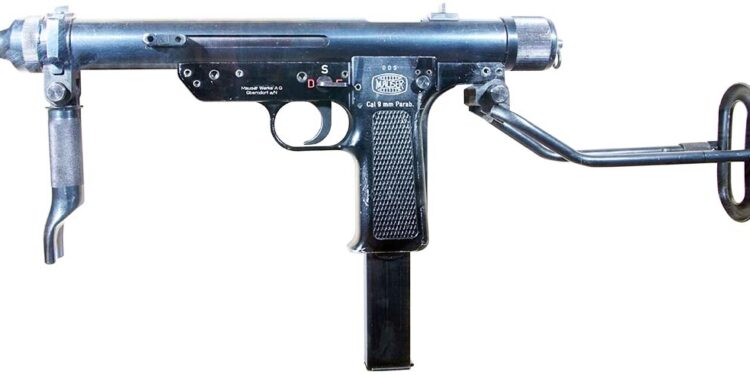By Michael Heidler
The newly created Bundeswehr (German Federal Army) received its initial equipment of weapons, vehicles and equipment mainly from U.S. stocks. Among them were M1 Garand rifles, M1 and M2 carbines, Thompson M1A1 submachine guns, BAR and M1919 machine guns, bazookas and much more. With the transfer of 9,572 Federal Border Guard members to the Bundeswehr in July 1956, numerous weapons and equipment of the former Wehrmacht complemented the Bundeswehr inventory.
Since the beginning of the 1950s, the once so-progressive German armament industry has been allowed to get back to developing new weapons. In the meantime, most manufacturers had kept their heads above water with civilian products or entered into cooperation agreements with foreign companies. The first thing to do was to orientate themselves on the market. Many of the early German post-War submachine guns showed little technical progress and were still very similar to their predecessors from the War period.

One of the first companies to get back into military weaponry was the former Thuringian company Erfurter Maschinenfabrik (Erma) at its new West Germany location in Dachau near Munich in Bavaria. In cooperation with the French designer Louis Bonnet de Camillis, a compact weapon in 9x19mm caliber was developed. Its pistol grip also served as a magazine well. Its official designation was MP-56, but unfortunately the exact processes in the background stay in the dark. Anyway, a foreign client financed the development costs and the production of 10 prototypes. Erma did not get more out of it, because the client also owned the rights to the design and sold it to the Mauser company in Oberndorf at the beginning of 1957.
At Mauser, the designer Ludwig Vorgrimler, who recently returned from Spain, reworked the weapon in some detail, but the basic construction remained largely the same. The official designation at Mauser was now MP-57. The weapon resembles a pistol in appearance, is very compact with only 16.8 inches in length and weighs less than 9 pounds with a full magazine. For the sake of simplicity, Erma used the 32-round magazine of the German wartime submachine gun MP 40, although these certainly had their weaknesses in the cartridge feed. Mauser stuck with this decision.

The MP is blowback-operated and fires from a closed bolt. Its simple receiver is cut from tube material, and the grip piece is riveted together from sheet metal parts. The breechblock encloses the barrel with its front half, so that a large part of its mass is located in the center of gravity. This saves on length of the receiver, and the weapon is more pleasant to shoot in fully automatic mode.
The “S” position of the fire selector lever and an additional grip safety, which only releases the bolt when the grip is firmly grasped by the shooter’s hand, serve as safety devices. Erma’s prototypes did not yet have a shoulder stock. A wire stock that could be folded upwards onto the receiver was added. Further, the foldable foregrip got a different shape and was now better adapted to the receiver. The sight is of a very rudimentary design: a fixed rear sight for 100m and an unprotected front sight. According to the test report the rate of fire was 700 rounds per minute (rpm).
In the years 1955 to 1959, extensive testing and comparisons of old and new submachine guns took place at the Bundeswehr test site for weapons and ammunition in Meppen in the Emsland region. The field of participants was international. Beside German manufacturers like Walther and Mauser, there were also competitors like the British Sterling, Swedish Carl Gustaf m/45 or the Italian Franchi LF-57. In the reports the Mauser MP-57 is only described technically, but nothing is known about its performance compared to its competitors. What is certain is that Mauser’s weapon did not make it onto the shortlist. After a total of four prototypes and 25 pilot series, Mauser stopped the production.

After this failure, Vorgrimler and a technician named Kimmick went to work again, and by 1960 the new MP60 was available for further trials. It looked clunkier and less pleasing than the MP-57. The foregrip was eliminated, the magazine was inserted into a separate magazine well in front of the grip piece, and the barrel was covered by a perforated jacket. But the new weapon was supposed to arouse the interest of the military with another special feature: It could launch rifle grenades. The distinctive muzzle flash hider served as a guide for the attached grenade. The weapon fires from a closed bolt, and by turning the fire selection lever to position “G” (Grenade), the bolt is locked in its forward position; this way the entire gas pressure of the propellant cartridge acts on the rifle grenade. In position “F” (Feuer) the weapon fired continuous fire. Semiautomatic fire was no longer intended. Mauser had also developed a new 36-round stick magazine especially for this weapon.
In the end, Mauser—just like many other German arms manufacturers—was denied success because the German Armed Forces had long since decided in favour of the Israeli UZI for political reasons. For Mauser, this was the end of their history of designing and manufacturing submachine guns. The two weapons featured here are part of the collection of the arms museum located in the old Mauser factory called Schwedenbau (Swedish building) in Oberndorf.

Technical Data: MP-57 MP60
Caliber: 9x19mm 9x19mm
Length (stock extended): 23.2in 30.2in
Length (stock retracted): 16.8in 19.9in
Length of barrel: 10.4in 9.8in
Weight (empty): 7.23lb 6.83lb
Magazine capacity: 32 rounds 36 rounds
Rate of fire: 700 rounds/min 750 rounds/min
The author would like to thank Mr. Kussmann-Hochhalter from the city archive and museum Oberndorf for his support.
| This article first appeared in Small Arms Review V25N1 (January 2021) |












